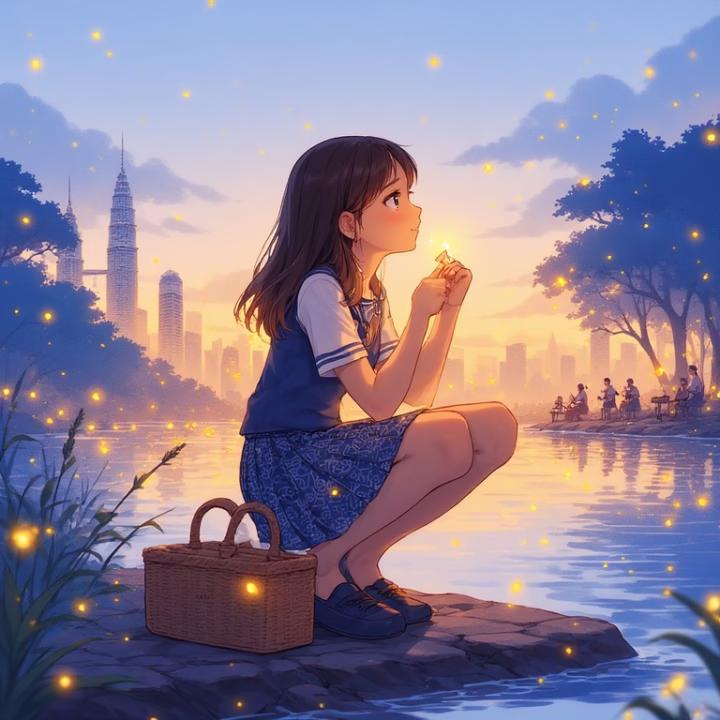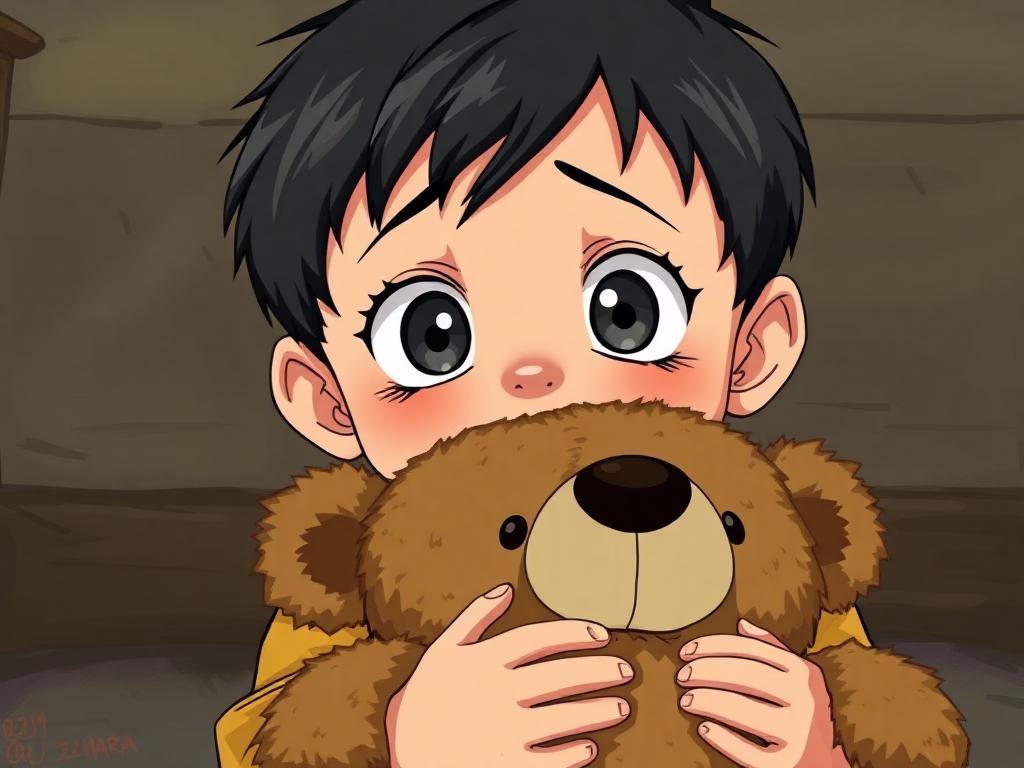
Amirah had forgotten what silence felt like.
Not the kind of silence that comes after bedtime, when the ceiling fan whirs and distant traffic hums like a lullaby. No — she meant real silence. The kind that breathes. The kind where leaves whisper secrets to each other, frogs croak in rhythm, and the night doesn’t glare back at you with neon signs and streetlights.
She’d moved to Kuala Lumpur three years ago, when her father got a job managing a high-rise hotel downtown. Their new apartment had floor-to-ceiling windows, Wi-Fi faster than lightning, and a view of the Petronas Towers that glittered like twin crowns. But it didn’t have fireflies.
Not one.
Back in her kampung — a sleepy village tucked between rubber trees and rice paddies — summer nights had been magic. She’d chase flickering lights with her cousins, cupping them gently in her palms, whispering wishes before letting them go. Her grandmother used to say, “Each firefly carries a piece of the moon’s glow. Lose them, and the night forgets how to dream.”
Amirah hadn’t believed her then.
Now, standing at the edge of Lake Perdana in Taman Tasik Perdana — KL’s oldest park — she wasn’t sure she believed anything anymore.
Except… what was that?
A flicker. Faint. Yellow-green. Darting just above the water’s surface.
Her breath caught.
She blinked. Rubbed her eyes. Looked again.
There — it pulsed once, twice, then vanished behind a cluster of reeds.
“Did you see that?” she whispered, turning to her little brother, Haris, who was busy poking a stick into the mud.
“See what?” he mumbled, unimpressed.
“A firefly!”
Haris snorted. “Those don’t live in cities. Everyone knows that.”
But Amirah had seen it. She was sure.
And it looked… tired.
The next evening, Amirah returned alone. She brought a notebook, a pencil, and her grandmother’s old magnifying glass — the one with the chipped handle and smudged lens. She sat cross-legged beneath a banyan tree, eyes scanning the waterline as dusk painted the sky in lavender and tangerine.
Minutes passed. Then — there it was again.
The same flicker. Same path. Same weak pulse.
It didn’t dart or dance like the fireflies of her childhood. It drifted. Like a candle flame about to go out.
Amirah crept closer, careful not to startle it. The firefly landed on a water lily leaf, wings trembling.
She crouched low.
Up close, it was smaller than she remembered. Its glow was dim, almost gray at the edges. One wing looked bent. And its antennae? Barely moving.
“You’re not supposed to be here,” she murmured. “Cities eat things like you.”
The firefly pulsed once — slow, sad.
Amirah’s chest tightened.
She pulled out her notebook and wrote:
Day 1: Saw a firefly. Only one. Looks sick. Why is it here? Why is it ALONE?
She didn’t know what to do. Call animal control? Take it to a vet? Did vets even treat fireflies?
She needed help.
Her first stop was the park ranger’s station — a little wooden hut near the playground, painted green with peeling edges. Inside, Ranger Laila sat behind a cluttered desk, sipping teh tarik from a chipped mug.
“Fireflies?” Laila repeated, raising an eyebrow. “In this park? Girl, the last recorded sighting was in the 90s.”
“I saw it,” Amirah insisted. “Twice. It’s real. And it’s… fading.”
Laila studied her for a long moment. Then she sighed, put down her mug, and opened a dusty filing cabinet.
“Alright. Let’s say you’re not imagining things.” She pulled out a yellowed folder labeled “Fauna: Extinct or Endangered — KL Central.” “Fireflies need three things to survive: clean water, dark skies, and specific plants for their larvae to eat. We’ve got polluted runoff from the roads, LED streetlights that never turn off, and half our native shrubs got replaced with ornamental imports.”
She tapped the folder. “No wonder they vanished.”
“But this one’s still here,” Amirah said. “It’s trying.”
Laila smiled faintly. “Then maybe it’s waiting for someone like you.”
She handed Amirah a map of the park. “Start here. Check the reed beds, the old fig trees near the lake’s north bend. And talk to Pak Harun. He used to be head botanist at FRIM. Retired now, but he walks the trails every morning. If anyone knows about lost species, it’s him.”
Pak Harun was exactly where Laila said he’d be — sitting on a stone bench beneath a rain tree, feeding pigeons with one hand and reading a thick botany book with the other. He wore a wide straw hat and suspenders over a faded batik shirt. His eyes twinkled like polished river stones.
“Fireflies, eh?” he said after Amirah breathlessly told him everything. “Ah… Pteroptyx tener. The synchronous firefly. Used to blanket this lake in the 70s. Thousands of them. Looked like stars had fallen into the water.”
He closed his book. “You know why they disappeared?”
Amirah shook her head.
“Progress,” he said simply. “We paved over their nurseries. Lit up the night so bright, they couldn’t find each other to mate. Poisoned the water with oil and trash. Fireflies aren’t stubborn creatures, child. They’re delicate. They leave when the world becomes too loud.”
“But this one didn’t leave,” Amirah whispered.
Pak Harun leaned forward. “Then it’s either very brave… or very lost.”
He stood, brushing crumbs off his pants. “Come. Let’s find your friend.”
They found the firefly again that night — same spot, same leaf. It barely reacted when Amirah approached. Its glow was weaker now. Barely there.
Pak Harun knelt beside her. “It’s not just sick. It’s lonely. Fireflies communicate through light. Without others… it has nothing to say.”
Amirah’s eyes stung. “Can we fix it?”
“We can try,” he said. “But we’ll need more than two pairs of hands.”
Enter: The Street Artists.
Amirah found them painting a mural near the park’s entrance — three teens in paint-splattered jeans, turning a drab concrete wall into a jungle of glowing vines and hidden animals. Their leader, a girl named Zara with electric-blue hair and a nose ring, listened intently as Amirah explained.
“A dying firefly? And you want us to… what? Paint it better?”
“No,” Amirah said. “I want you to help me make the park remember fireflies. Make people see them again. Even if they’re not really here yet.”
Zara grinned. “Ohhh. You want magic.”
They got to work the next day.
Using glow-in-the-dark paint — eco-friendly, non-toxic, charged by sunlight — they painted fireflies along the walking paths. Not just dots. Stories. Fireflies dancing over lilies. Fireflies spelling out “SAVE ME” in Morse code. Fireflies forming constellations above benches.
“People will think they’re real at night,” Zara said proudly, stepping back to admire their work. “And maybe… they’ll start looking for the real ones again.”
But paint wasn’t enough.
The firefly — Amirah had started calling her Seri, short for Serigala Cahaya, “Wolf of Light” — was fading faster. Her glow now only flickered when Amirah hummed her grandmother’s lullabies.
They needed darkness.
Real, deep, quiet darkness.
That’s when Amirah had her most daring idea.
She wrote a letter.
Not to the mayor. Not to the newspaper.
To the KL Light & Power Company.
Dear Sir/Madam,
There is one firefly left in Taman Tasik Perdana. She is dying because your streetlights are too bright. Please turn them off for one hour. Just one. From 8 to 9 PM. Let the park breathe. Let her remember what it’s like to glow without competition.
If you say no, I’ll sit in front of your building with a sign until you change your mind.
Sincerely,
Amirah (Age 11, Firefly Guardian)
She mailed it. And waited.
Three days later, a man in a crisp suit showed up at the park.
“I’m Mr. Azlan from KL Light & Power,” he said, adjusting his tie. “Your letter… caused quite a stir.”
Amirah held her breath.
“We can’t turn off all the lights,” he said. “Safety regulations. But…” He pulled out a tablet. “We can dim the ones around the lake by 70%. Install amber filters — less disruptive to wildlife. And for one hour, every Friday night… we’ll switch them off completely.”
Amirah’s jaw dropped. “Really?”
He smiled. “Turns out, several employees have kids who read your letter. One even cried. Said she missed chasing fireflies with her nenek.”
The changes began.
Park rangers planted native ferns and water celery along the shore — food for firefly larvae.
Zara and her crew expanded their murals, adding QR codes that linked to firefly facts.
Pak Harun hosted “Twilight Talks” every Thursday, teaching kids about nocturnal ecosystems.
And every Friday at 8 PM, the lights around Lake Perdana dimmed… then went out.
The first Friday, only Amirah and Haris came. They sat on the grass, holding their breath.
At first — nothing.
Then, a flicker.
Not Seri.
A new one.
Then another.
And another.
Tiny, hesitant lights, rising from the reeds like embers from a hidden fire.
Seri, resting in Amirah’s cupped hands, pulsed — stronger than she had in weeks.
She lifted gently into the air… and joined them.
The sky above the lake shimmered. Dozens of fireflies — maybe hundreds — blinking in slow, synchronized waves. Not the frantic chaos of city lights. Not the sterile glow of LEDs.
This was a language. A song. A memory returning.
Amirah didn’t cry. Not yet.
She just watched, heart full, as the lake remembered how to dream.
Weeks passed.
The fireflies didn’t vanish after one night. They stayed. Laid eggs in the ferns. Taught their young to glow.
Tourists came with cameras. Scientists came with notebooks. Children came with jars — but now, they knew to let the fireflies go.
Seri? She became something of a legend.
The firefly who waited. The firefly who believed. The firefly who brought the others home.
Amirah still visited every evening. Sometimes Seri would land on her shoulder, pulsing gently, as if to say thank you.
One night, as Amirah sat beneath the banyan tree, Pak Harun joined her.
“You did good, little guardian,” he said.
“I didn’t do it alone,” she replied.
“No,” he agreed. “But you were the spark.”
He handed her a small, smooth stone. “For your collection.”
She turned it over. Painted on its surface was a single firefly — glowing bright gold.
“Seri?” she asked.
He nodded. “So you never forget what one small light can do.”
On the last Friday of the school term, the park held a “Night of a Thousand Glows.” Hundreds of people gathered — kids, parents, rangers, artists, even Mr. Azlan from the power company. Lanterns hung from trees (solar-powered, of course). Music played softly — flutes and gamelan, nothing too loud. And at 8 PM, as always, the lights went out.
The fireflies rose.
Not in ones or twos.
In clouds.
A living galaxy swirling above the lake, pulsing in perfect, silent harmony.
Amirah stood at the water’s edge, Haris beside her, Seri glowing proudly on her fingertip.
“She’s not the last anymore,” Haris whispered, eyes wide.
Amirah smiled. “No. She’s the first of the next thousand.”
And as the crowd gasped, pointed, and laughed in wonder, Amirah made a silent promise — to the fireflies, to the lake, to herself.
I’ll never let the world forget you again.
Epilogue: One Year Later
Amirah’s notebook is now full.
Page after page of sketches, maps, firefly counts, weather notes, and pressed ferns. On the cover, she’s written:
The Firefly Diaries: Volume One — How We Brought Back the Night
She still visits the lake every evening.
Seri? She’s still there. Older now. Slower. But her glow? Brighter than ever.
And she’s not alone.
Thousands flicker above the water now. Scientists say it’s a miracle. Rangers call it a conservation success story.
Amirah calls it hope.
Sometimes, when the lights go out and the fireflies rise, she swears she hears her grandmother’s voice on the breeze:
“See, anak? Even the smallest light can remind the world how to shine.”
And Amirah? She’s already planning Volume Two.










